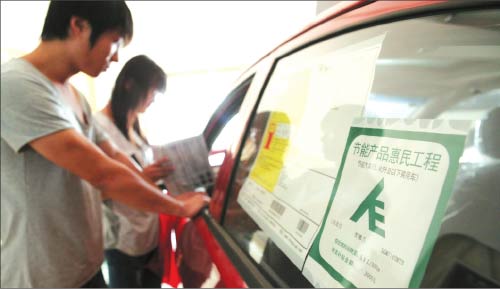 |
|
Already armed with a range of information they gathered themselves, today's buyers make their final decisions at a dealership, where the most important factors for a model are comfort, word-of-mouth reputation, promotional deals and fuel efficiency. [SI WEI/ FOR CHINA DAILY] |
Survey: A changing sales pitch as buyers do their own research
The growing use of online information by consumers has profoundly changed the car buying process in China, bringing both opportunities and challenges for automakers, a recent study found.The joint survey by global market research company Nielsen and China's automobile website Autohome in November found consumers are making decisions faster, indicating that automotive brands cannot afford to lose any opportunity to engage with potential buyers.
The study based on sampling of more than 7,000 off-line auto consumers and more than 15,000 Autohome online users aims to map out new trends in today's Internet-savvy automobile buyers.
Instead of passively absorbing information, consumers are proactive in seeking out data themselves, the survey found.
According to Nielsen's analysis, precision marketing on the right platform has become the most effective way to convert intentions to buy into to real purchases.
How to differentiate
China is now the world's most competitive automotive environment so carmakers must differentiate themselves in a crowded market of 1,699 models from 249 brands.
Despite growing options, the length of time it takes buyers to make a purchase decision has actually shortened. According to the Nielsen survey, 77 percent of respondents said the full process took less than 90 days, while 30 percent made their choice within a month.
Surprisingly, shorter decision periods have come even as consumers consider a larger range of models.
According to Autohome, even at the final stage of their purchase journey, online users still consider as many as 42 models in a single month, with in-depth evaluation of 16.
Data from the Autohome site also indicated that stated model preferences do not necessarily correlate with online browsing behavior.
"When facing constantly changing buyers, automotive brands need to effectively keep engaging with their consumers-only in this way can they keep their brands on consumers' consideration list," said Ganesh Relekar, vice-president of Automotive Vertical, Nielsen China.
Sourcing information
Despite growing ad spending on traditional media, the effectiveness, particularly for TV, remains questionable, the survey found.
The declining importance of traditional media like TV, newspapers, magazines and radio has been gradually replaced with personal recommendations, 4S stores and professional auto websites.
The survey indicates that on the Autohome website alone, the average auto user will spend more than 20 hours in the last month of the purchase process before coming to a decision.
"Today, Chinese consumers are more used to searching for information on their own, and actively seeking feedback from other users," said Relekar. "New media platforms are enabling such active involvement. The information provided by traditional media no longer meets the changing demands of consumers.
"By fully leveraging the strength of the Internet and social media platforms, automotive brands should keep up with the behavior of their consumers to customize content and platforms, and eventually, win the hearts and minds of their potential buyers."
Identifying consumers
According to the study, consumers first filter vehicles to fit in their budgets and practical needs. They then do in-depth comparisons in their model pool to further shorten the list of their preferred models and brands. The last stage happens at actual dealerships, so marginal advantages or incentives may lead to final decisions.
The survey shows winning factors vary by stage.
At the browsing stage, the top three factors that buyers take into account are safety, budget and brand preference.
At the comparison stage, the focus shifts to design, features, specs and word-of-mouth reputation. While making the final decision at a dealership, the most important factors include comfort, word-of-mouth reputation, promotion and fuel efficiency.
Similarly, buyers' preferred information channels vary by stage. During the browsing stage, consumers tend to rely on search engines, news and motoring sites. At later stages, they turn to real customer feedback and promotion information on message boards.
"By analyzing and tracking the behavior of the online consumers, it's now possible for automakers to precisely identify the purchase stage of potential buyers, and by optimizing the media touch point, they can truly customize content and platforms to reach their potential buyers at the right moment and exert the greatest influence on their decisions," said Relekar.
The Internet also helps automakers by identifying potential clients.
"The application of big data makes it possible for auto brands to know consumer needs, tastes, purchase capabilities and media preferences, all of which are important for brands to strike a chord with their audience through tailormade content and the right channels," said Relekar.
"Even when these potential buyers haven't yet decided to buy a car, it could serve as an early opportunity for brand preference cultivation, which will be very useful to converting them into real buyers later on."
Relekar said in addition to working with Autohome, Nielsen is working to integrate information from a broader range of big data sources.
"We have seen strong momentum in applying big data to precision marketing for automotive brands. It's the future we are heading toward," he added.
